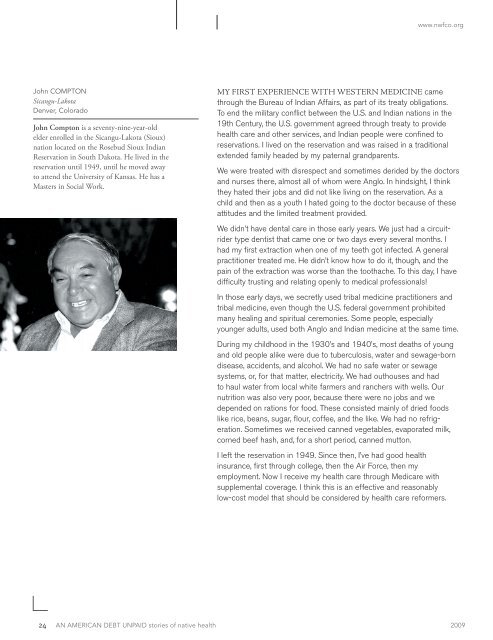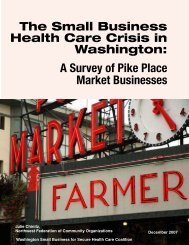An American Debt Unpaid: Stories of Native Health - Alliance for a ...
An American Debt Unpaid: Stories of Native Health - Alliance for a ...
An American Debt Unpaid: Stories of Native Health - Alliance for a ...
You also want an ePaper? Increase the reach of your titles
YUMPU automatically turns print PDFs into web optimized ePapers that Google loves.
www.nwfco.orgJohn COMPTONSicangu-LakotaDenver, ColoradoJohn Compton is a seventy-nine-year-oldelder enrolled in the Sicangu-Lakota (Sioux)nation located on the Rosebud Sioux IndianReservation in South Dakota. He lived in thereservation until 1949, until he moved awayto attend the University <strong>of</strong> Kansas. He has aMasters in Social Work.My first experience with western medicine camethrough the Bureau <strong>of</strong> Indian Affairs, as part <strong>of</strong> its treaty obligations.To end the military conflict between the U.S. and Indian nations in the19th Century, the U.S. government agreed through treaty to providehealth care and other services, and Indian people were confined toreservations. I lived on the reservation and was raised in a traditionalextended family headed by my paternal grandparents.We were treated with disrespect and sometimes derided by the doctorsand nurses there, almost all <strong>of</strong> whom were <strong>An</strong>glo. In hindsight, I thinkthey hated their jobs and did not like living on the reservation. As achild and then as a youth I hated going to the doctor because <strong>of</strong> theseattitudes and the limited treatment provided.We didn’t have dental care in those early years. We just had a circuitridertype dentist that came one or two days every several months. Ihad my first extraction when one <strong>of</strong> my teeth got infected. A generalpractitioner treated me. He didn’t know how to do it, though, and thepain <strong>of</strong> the extraction was worse than the toothache. To this day, I havedifficulty trusting and relating openly to medical pr<strong>of</strong>essionals!In those early days, we secretly used tribal medicine practitioners andtribal medicine, even though the U.S. federal government prohibitedmany healing and spiritual ceremonies. Some people, especiallyyounger adults, used both <strong>An</strong>glo and Indian medicine at the same time.During my childhood in the 1930’s and 1940’s, most deaths <strong>of</strong> youngand old people alike were due to tuberculosis, water and sewage-borndisease, accidents, and alcohol. We had no safe water or sewagesystems, or, <strong>for</strong> that matter, electricity. We had outhouses and hadto haul water from local white farmers and ranchers with wells. Ournutrition was also very poor, because there were no jobs and wedepended on rations <strong>for</strong> food. These consisted mainly <strong>of</strong> dried foodslike rice, beans, sugar, flour, c<strong>of</strong>fee, and the like. We had no refrigeration.Sometimes we received canned vegetables, evaporated milk,corned beef hash, and, <strong>for</strong> a short period, canned mutton.I left the reservation in 1949. Since then, I’ve had good healthinsurance, first through college, then the Air Force, then myemployment. Now I receive my health care through Medicare withsupplemental coverage. I think this is an effective and reasonablylow-cost model that should be considered by health care re<strong>for</strong>mers.24 AN AMERICAN DEBT UNPAID stories <strong>of</strong> native health 2009




